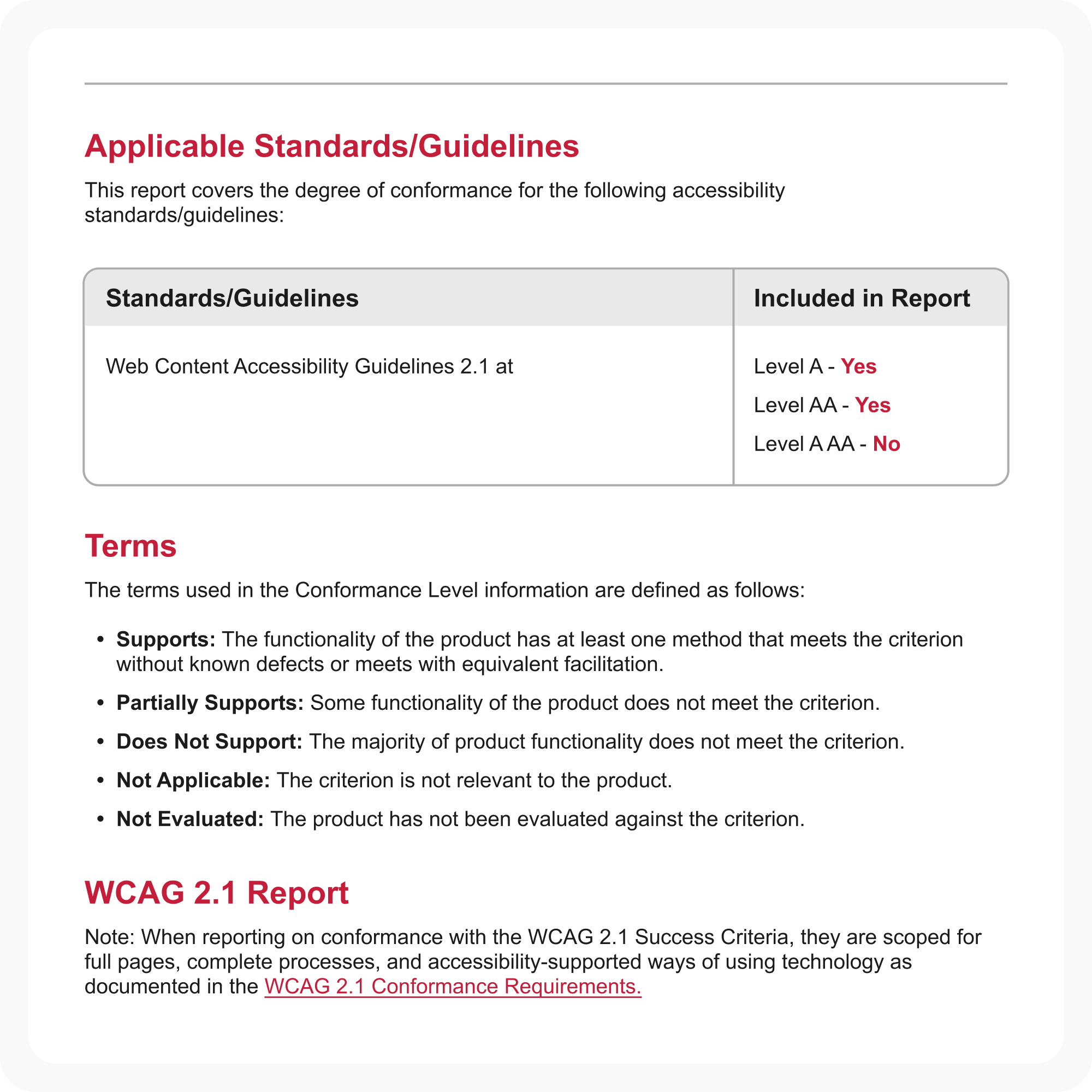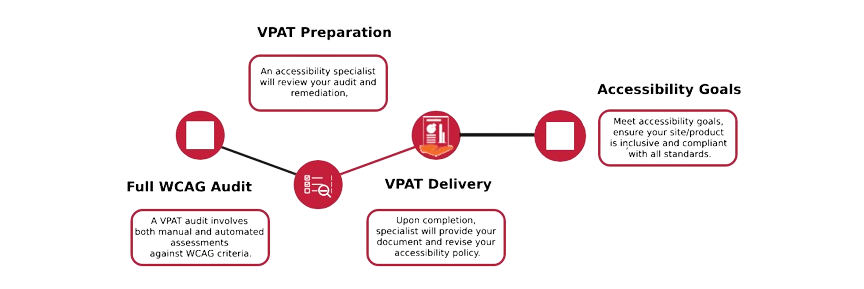VPAT Report Services
A VPAT outlines a product’s conformance with accessibility guidelines, highlighting any accessibility barriers in its features or functionalities. It serves as a declaration of the product’s accessibility status, either confirming full compliance or explaining deviations, which are typically rare and only acceptable in cases where achieving 100% compliance is genuinely impractical.

What is a VPAT Report
At Accessibility Partners Canada, our Accessibility Audit Report and Accessibility Evaluation Report services are designed to provide a detailed assessment of your website’s accessibility status. We help organizations ensure that their digital assets are accessible to all users, including those with disabilities, by identifying areas that need improvement and offering actionable solutions for compliance with accessibility standards such as WCAG 2.2.
What Does our VPAT Report Include
Structure
VPAT reports follow a standardized format and typically consist of several sections, including an executive summary, product details, tests and results, and an assessment of conformance to specific accessibility standards.
Accessibility evaluation
The VPAT report assesses various aspects of your product’s accessibility, such as compatibility with assistive technologies, keyboard accessibility, navigation, color contrast, alternative text for images, and more. It may list specific accessibility standards or guidelines used for the evaluation, like the EN 301 549 and Web Content Accessibility Guidelines (WCAG).
Conformance levels
VPAT reports often indicate the level of conformance with accessibility standards using a scale defined by the template. The scale may include levels like “Supports,” “Partially Supports,” or “Does Not Support” to clearly communicate your product’s accessibility compliance.
Product details
The VPAT report provides information about the product or service being evaluated, including its name, version, and any relevant specifications. It may also include details about the environment in which the assessment was conducted, such as operating systems, browsers, and assistive technologies used.
Test procedures and results
The VPAT report outlines the methods and tools used to evaluate accessibility. It describes the specific tests performed and provides an overview of the results, including any barriers or limitations discovered during the assessment.
Recommendations
Depending on the evaluation results, VPAT reports may include recommendations for improving accessibility. These recommendations can help you identify areas for enhancement and prioritize remediation efforts.
Accessibility Audit Report Service from Accessibility Partners
At Accessibility Partners Canada, our Accessibility Audit Report and Accessibility Evaluation Report services are designed to provide a detailed assessment of your website’s accessibility status. We help organizations ensure that their digital assets are accessible to all users, including those with disabilities, by identifying areas that need improvement and offering actionable solutions for compliance with accessibility standards such as WCAG 2.2.
Our VPAT Report Process

Need AODA/ACA Compliance Help?
Is Your Organization Undergoing an Audit? Need Expert Help with Your Compliance Report?
Why get a VPAT Report Service from Accessibility Partners
Trusted by major municipalities and endorsed by provincial and federal initiatives, Accessibility Partners Canada combines authentic lived experience with technical expertise to lead the way in accessibility compliance management. Our VPAT services guided by specialists who bring direct insights into the needs of users with disabilities.
Detailed Reports
Our accessibility reports provide everything you need to understand the accessibility of your website. From high-level executive summaries to deep-dive remediation guides, we cover all aspects.
Customized Solutions
We tailor our remediation suggestions to your website’s unique needs, ensuring each fix is practical and sustainable.
Industry-Recognized Tools
We use a combination of industry-standard tools such as Compliance Deputy, aXe, WAVE, and screen readers like JAWS and NVDA to ensure thorough and accurate testing.
Expert Guidance
Our accessibility experts not only identify issues but also guide you on the best ways to resolve them, improving your website’s usability and compliance.
Proven Track Record
Having won multiple government Vendor Qualification processes, we are a trusted partner in accessibility services for all three levels of government—federal, provincial, and municipal.
We ensure your digital products meet evolving standards, enabling your organization to serve all users effectively while minimizing compliance risks. By choosing Accessibility Partners Canada, you’re selecting a partner committed to high-impact accessibility that resonates across diverse user bases.
Frequently Asked Questions (FAQs)
Organizations selling digital products or services to government entities often need a VPAT to demonstrate accessibility compliance.
If your customers include government agencies or institutions with strict accessibility requirements, a VPAT is likely needed.
Timelines depend on product complexity, typically ranging from a few days to several weeks.
It details how well a product or service meets accessibility standards like WCAG, Section 508, and EN 301 549.
Accessibility specialists review each compliance criterion, scoring accessibility against established standards.
Yes, our services are fully customizable to meet your specific requirements. Whether you need remediation for internal documents, public-facing content, or specialized reports, we tailor our approach to suit your needs.
